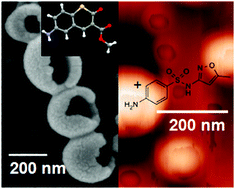Fabrication of egg shell-like nanovesicles from a thiocoumarin-based ε-amino ester: a potential carrier†
Abstract
Nanoscale egg shell-like drug delivery systems from methyl 6-amino-2-oxo-2H-thiochromene-3-carboxylate, a thiocoumarin-based ε-amino ester, have been investigated as potential candidates for drug delivery vehicles. X-ray crystallography reveals that the ε-amino ester adopts a planar structure and self-associates to form a four-membered ring-like porous architecture through multiple N–H⋯O and C–H⋯S intermolecular hydrogen bonding interactions. At higher order packing, the ε-amino ester forms an anti parallel sheet-like structure by intermolecular hydrogen bonding as well as face-to-face π–π stacking interactions. Field emission scanning electron microscopy (FE-SEM) revealed that the ε-amino ester exhibits an egg shell-like porous nanovesicle morphology. These egg shell-like nanovesicles have been used as a potential carrier for the bacteriostatic antibiotic sulfamethoxazole. The spectroscopic studies as well as the growth inhibition of E. coli exhibit that the ε-amino ester-sulfamethoxazole formulation leads to pH responsive sustained release of the drug. This report highlights the utility of designer amino acid-drug supramolecular combinations.



 Please wait while we load your content...
Please wait while we load your content...